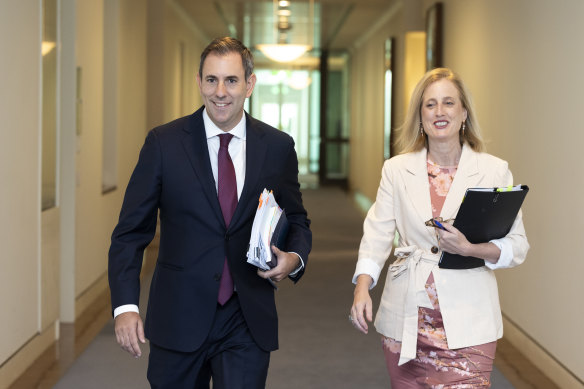More tax from workers, businesses improves federal budget
Save articles for later
Add articles to your saved list and come back to them any time.
A surge in tax from workers and companies has helped deliver the Albanese government a $40 billion improvement in the federal budget bottom line over four years, with predictions Australians will start seeing real wage increases early next year.
The mid-year budget update, released on Wednesday morning by Treasurer Jim Chalmers and Finance Minister Katy Gallagher, forecasts this year’s deficit will be $1.1 billion, a $12.8 billion strengthening on expectations in May.
Treasurer Jim Chalmers and Finance Minister Katy Gallagher released the mid-year economic update on Wednesday.Credit: Alex Ellinghausen
Chalmers said the government’s budget management had nearly wiped out the forecast deficit for this financial year, but he was taking a cautious approach to forecasting a second budget surplus.
“We are not yet forecasting a second surplus, but we are within striking distance. We have given ourselves a chance, but we aren’t there yet,” he said.
Between 2023-24 and 2026-27, the government is expecting to run up $74.5 billion in deficits, compared to the May budget forecast of a cumulative $114.1 billion.
The smaller deficits will help reduce government debt. By the end of this financial year, gross debt is expected to be $909 billion – $14 billion lower than had been forecast.
The improvement has been largely driven by much stronger tax collections. This year alone, the government has upgraded forecast revenue from working Australians by $8.9 billion to a record $328.3 billion.
Company tax collections have been revised up by $9.2 billion to a record $137.9 billion. Total tax collections have been upgraded by $64.4 billion over the forward estimates.
The stronger tax receipts are due to a lift in wages growth, a better than expected jobs market and continuing high prices for key commodities.
So large is the surge in tax, that these receipts will reach 23.7 per cent of GDP – the highest share since the final budget of John Howard’s government in 2007-08.
It is then expected to fall as the stage 3 tax cuts start from the middle of next year.
Treasury has upgraded its outlook for the economy this year, tipping it to grow by 1.75 per cent. In May, it had forecast growth of 1.5 per cent.
Total employment is expected to grow by 1.5 per cent (from 1 per cent in May), while the jobless rate is tipped to reach 4.25 per cent by the middle of next year.
Inflation is now expected to lift by 3.75 per cent this year, half a percentage point higher than forecast in May. It is then expected to ease to 2.75 per cent in 2024-25.
Wages are expected to grow by 4 per cent this year before slowing to 3.25 per cent the following year.
Chalmers said the budget update was all about responsible economic management.
“Responsible economic management: it’s what puts downward pressure on inflation and eases the cost of living and because of our efforts, we are getting the budget in much better nick and making more room for our priorities, and that’s what these numbers that we’re releasing today show,” he said.
Chalmers said the government understood that Australians were doing it tough and the economy was slowing, which was why it was repairing the budget bottom line, rolling out cost-of-living relief and fighting inflation.
New government decisions added $1.1 billion to government spending this financial year, and $6.5 billion to spending over the four years to 2026-27.
But the government is saving or reallocating $9.8 billion, with the biggest saving its $7.4 billion cut to infrastructure spending for the states.
Gallagher said the additional $9.8 billion in savings found in the budget update took total savings found since Labor came to office to $50 billion, “which of course helps in our fight against inflation”.
“Of the net spend in this MYEFO – $5.2 billion – about 99 per cent of that relates to unavoidable urgent or dealing with legacy issues,” she said.
“So things like closing the pandemic event visa, our continued response COVID-19, our response to red fire ants, there are backlogs in Services Australia customer support, the robo-debt response as well.”
Cut through the noise of federal politics with news, views and expert analysis from Jacqueline Maley. Subscribers can sign up to our weekly Inside Politics newsletter here.
Most Viewed in Politics
From our partners
Source: Read Full Article
